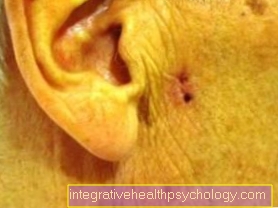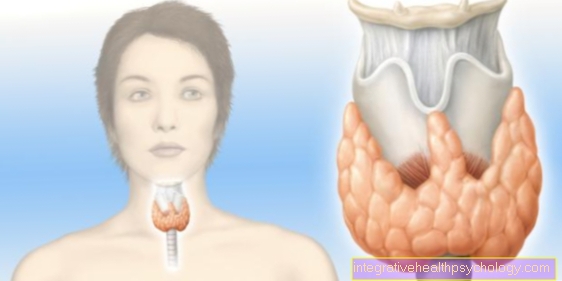Skin cancer screening
introduction
The skin cancer screening (skin cancer screening) is an examination that is carried out on as many people as possible in order to early To recognize skin cancer diseases and to be able to treat them as a result.
In Germany, the statutory health insurance companies have been offering a comprehensive skin cancer prevention program since July 1, 2008, as the number of skin cancer cases in Germany has risen sharply in recent years (to over 230,000 people throughout Germany per year).
Every legally insured person from the age of 35 has a right to skin cancer screening. The examination can be carried out by the family doctor or dermatologist every two years. Patients with an increased risk of developing skin cancer should take the screening earlier.
The preventive medical check-up for the early detection of skin cancer is therefore sensible, as it enables a cure in almost all cases. The screening program aims to discover early stages of skin cancer in order to improve the chances of recovery and to ensure that as many people as possible do not become ill in the first place.
Read more on the subject here: White skin cancer

Common skin cancers
The three most common skin cancers are spinocellular carcinoma, basal cell cancer (Basalioma) and malignant melanoma. The first two forms are popularly referred to as "white" or "light" skin cancer in order to differentiate them from malignant melanoma or "black" skin cancer.
The white skin cancer (spinocellular carcinoma and Basal cell cancer) occur mainly in the elderly. They usually show slow and less aggressive growth and very rarely form metastases (Scatter flocks) in other parts of the body. Nevertheless, like a malignant tumor, they can damage the surrounding tissue and penetrate into the surrounding bone, which is why they are sometimes referred to as partially malignant or semi-malignant skin cancers.
The biggest risk factor for that white skin cancer is the long-term effect of sun rays on the affected skin region. In contrast to malignant melanoma, frequent sunburns are not the cause of the tumors, but the direct exposure of the skin to UV rays. For this reason, most of the basal cell cancers are found in the face area: the lips, nose and auricle are particularly affected.
Black skin cancer (malignant melanoma) is the most feared form of skin cancer. It is very aggressive and forms tumor cells in other parts of the body (metastases) at an early stage, which is associated with a high mortality rate. Every year around 20,000 people in Germany develop malignant melanoma and around 15 percent of those affected die of the disease in the same year.
Risk factors

The most important risk factor for skin cancer is exposure to sunlight, because UV radiation from the sun damages various skin cells and can lead to their degeneration. However, exposure to artificial UV radiation (for example in a tanning salon) can damage cells over the years and thus increase the risk of skin cancer.
It has been proven that any sunburn that affects people with fair skin more often increases the risk of developing skin cancer. People who have a high number of large congenital birthmarks are also at an increased risk of skin cancer.
Further risk factors for skin cancer are a genetic predisposition (cancer in the family), environmental factors (for example occupational exposure to the chemical substance arsenic) as well as immunosuppression (weakened body's own defenses) due to other diseases or drugs.
Carrying out the skin cancer screening examination
The skin cancer check-up usually takes no more than fifteen minutes.
First, the person concerned is briefly questioned about their medical history (anamnesis), during which the doctor asks about previous illnesses and their state of health. Possible risk factors can also be uncovered in the conversation. Before screening, nail polish should be removed from fingernails, toenails, piercings and earrings to facilitate the physical exam that follows. Because even under the nails a conspicuous skin appearance can hide, which otherwise might go undetected. It is the same with make-up, which should be avoided for the examination so that the face can be examined properly. For the physical examination, the clothing is removed so that the doctor can examine the whole body with a trained eye and a bright lamp (scalp, the anal region and external genitalia, the oral mucous membranes, lips and gums).
If abnormal skin changes are found, a tissue sample can be taken, which is examined microscopically to confirm the diagnosis. In addition to the physical examination, the doctor can also provide important information for the correct use of the sun during skin cancer screening and provide information about further early cancer detection and health examinations.
Black skin cancer (melanoma) in particular can develop anywhere on the skin and mucous membranes, even in areas that are not directly exposed to the sun. For this reason, the gynecologist, dentist and ophthalmologist should also always have a look during the examination to see whether there are abnormalities in the internal genitalia, in the oral cavity or on the fundus that seem suspicious of skin cancer. These areas are not examined by the dermatologist and family doctor.
The following examinations, which are referred to as "individual health services" (IGeL), are not covered by the statutory health insurance companies:
- The examination with a reflected light microscope
- The photographic documentation
- The removal of benign, cosmetically annoying birthmarks or age-related irregularities of the skin (e.g. age warts).
Noticeable skin changes
The skin changes, which are looked for especially during the preventive examination, can be assessed according to the so-called "ABCDE rule".
- A (= asymmetry): This is true when the birthmark irregularly shaped is, so it does not have a smooth, round / oval / elongated shape, but rather looks jagged and misshapen. This criterion is also considered to be met if a pre-existing birthmark begins to change shape.
- B (= limitation): It is considered noticeable if the birthmark no sharp edge but is blurred or jagged with the surrounding skin. In the process, many smaller runners are often formed that shine into healthy skin.
- C (= Color): „Color"Translated from English means" color ". A birthmark is noticeable when it's out different colours exists, so it is not colored uniformly. Especially if the birthmark pink, gray or black spots or crusty deposits it should be examined by a dermatologist. It could be a malignant skin cancer.
- D (= diameter): Generally, all moles that are at their widest point should be one Diameter of 5mm exceed, to be assessed by a dermatologist. Same goes for birthmarks that take the shape of a Hemisphere to have.
- E (= sublimity): If you notice that the birthmark rises above normal skin level, you should consult a dermatologist if possible.
If two or more of these criteria apply to a suspicious mole, precautionary removal of the stain is recommended.
therapy

The most important measure in all skin cancers is the surgical Distance.
The earlier a noticeable skin lesion is removed as a whole, the better the chances of recovery. Especially with Tumorsthat are in a early stage are located, i.e. have not yet penetrated into the deeper layers of the skin or spread to other parts of the body (Metastases), complete removal of the tissue leads to healing. It should be sufficient Safety distance Be careful, this means that around one to two centimeters more tissue is removed from around the visible tumor. In the case of skin cancer of the face, the large safety margin can be dispensed with for cosmetic reasons and instead a more complex microscopically controlled removal can be considered, which also ensures complete removal of the malignant tissue.
In exceptional cases, a white skin cancer also one non-surgical Therapeutic measure can be chosen if an operation is not possible, for example due to the age or previous illnesses of the person concerned. However, in all forms of skin cancer, surgical removal is the so-called gold standard, even in old age.
Prevention
The main reason for the sharp rise in skin cancer in recent years is the change in leisure behavior, the increased use of solariums and intensive sun vacations all year round. Protection against the damaging UV radiation represents the most important and most effective measure for the prevention of skin cancer diseases. With the observance of a few rules that must be observed when dealing with the sun, sunburns can be avoided in a simple manner. In particular, parts of the body that are exposed to intense sunlight require special protection.These areas of the body should be kept covered or covered with Sunscreen with a high sun protection factor The bridge of the nose, the hairless scalp or the parting, cheeks, lips, ears, eyes, shoulders, the back or the cleavage are protected.
Also should be a awareness this creates how harmful the influence of the sun's rays is on our skin. Long sunbathing and sunburns are seen as completely normal and children and young people are also increasingly exposed to harmful solar radiation. Moderate use of the sun is important and necessary in order to prevent skin cancer.
forecast
In particular, recognized in time Preliminary stages of skin cancers that can be treated adequately early on by completely surgically be removed have a excellent prognosis. The skin manifestations, which are still in the early stages of development, have not yet penetrated into the deeper layers of the skin and have generally not yet caused any serious damage to the tissue.
But also the skin cancers, which are only recognized in more advanced stages, show particularly in the forms of white skin cancer a quality Forecast on. The Basalioma or that spinocellular carcinoma in most cases do not show aggressive growth and do not spread at all or only very late in other parts of the body, which is why they can usually be cured by surgical removal.
At the malignant melanoma The early detection of precursors is particularly important, since black skin cancer is a more advanced stage worse Has prognosis. Malignant melanoma usually grows quickly and aggressively, so that if it is discovered at a more advanced stage, it often already has one metastasis (Settlement) has taken place in other organs, which reduces the chances of therapy and healing.
Summary
The main concern of comprehensive skin cancer screening is the early detection of skin cancer diseases with the aim of being able to initiate timely treatment and thus the To lower the incidence and mortality rate. It is important to motivate the population to take part in the preventive examinations that are offered. Particularly when it comes to skin cancer prevention, there should be a thorough education about behavior that is harmful to the skin in order to reduce risk factors for the occurrence of skin cancer. In the long run, it is hoped that such comprehensive preventive examinations will also provide one Cost savings through disease prevention.





























